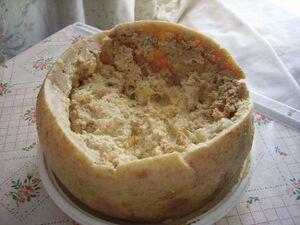Casu marzu cheese

Casu marzu (also called casu modde, casu cundhídu, or in Italian formaggio marcio) is a traditional ewes' milk cheese, notable for being riddled with live insect larvae. Although outlawed there for health reasons, it is found mainly in Sardinia, Italy on the black market. Casu marzu literally means "rotten cheese" in Sardinian and is known colloquially as maggot cheese.
Derived from Pecorino, Casu marzu goes beyond typical fermentation to a stage most would consider decomposition, brought about by the digestive action of the larvae of the cheese fly Piophila casei. These larvae are deliberately introduced to the cheese, promoting an advanced level of fermentation and breaking down of the cheese's fats. The texture of the cheese becomes very soft, with some liquid (called lagrima, from the Sardinian for "tears") seeping out. The larvae themselves appear as translucent white worms, about 8 millimetres (0.31 in) long. When disturbed, the larvae can launch themselves for distances up to 15 centimetres (6 in). Some people clear the larvae from the cheese before consuming; others do not.
Fermentation
Casu marzu is created by leaving large pieces of Pecorino cheese outside and letting it ferment. During the fermentation process, the eggs of the cheese skipper Piophila casei are either intentionally introduced to the cheese, or a female Piophila casei lays her eggs in the cheese, sometimes exceeding five hundred eggs at one time. The eggs hatch and the larvae begin to eat through the cheese. The acid from the maggots' digestive system breaks down the cheese's fats, making the texture of the cheese gooey and soft, with some liquid (called lagrima, from the Sardinian for "tears") seeping out. The larvae themselves appear as translucent white worms, about 0.33 inches (8.38 mm) long. By the time it is ready for consuming, a typical piece of Casu marzu will contain thousands of these maggots.
Consumption
Casu marzu is considered toxic when the maggots in the cheese have died. Because of this, only cheese in which the maggots are still alive is eaten. When the cheese has fermented enough, it is cut into thin strips and spread on moistened Sardinian flatbread (pane carasau), to be served with a strong red wine. Casu marzu is believed to be an aphrodisiac by local Sardinians. Because the larvae in the cheese can launch themselves for distances up to 15 centimetres (6 in) when disturbed, diners hold their hands above the sandwich to prevent the maggots from leaping into their eyes. Those who do not wish to eat live maggots place the cheese in a sealed paper bag. The maggots, starved for oxygen, writhe and jump in the bag, creating a "pitter-patter" sound. When the sounds subside, the maggots are dead and the cheese can be eaten.
Dangers
Several food safety issues have been raised in relation to Casu marzu, including anecdotal reports of allergic reactions and the danger of consuming cheese that has advanced to a toxic state. In addition, there is some risk of enteric myiasis, or intestinal larval infection. Symptoms include nausea, vomiting, abdominal pain, and bloody diarrhea. Piophila casei larvae are very resistant to human stomach acid and can pass through the stomach alive, taking up residency for some period of time in the intestines and causing stomach lesions and other gastrointestinal problems. The larvae have powerful mouth hooks which can lacerate stomach linings or intestinal walls as the maggots attempt to bore through internal organs.
The government of Sardinia has outlawed the cheese for health reasons, and offenders may face heavy fines. However, it is possible to get Casu marzu on the black market, where it can sell for double the price of a regular block of Pecorino.
Calories in different varieties and various types of cheeses
The number of calories in various types of cheese is very similar when you compare your cheese to a similar types of cheese.
For example, almost cheeses that are similar to Cheddar cheese have around 400 calories per 100g
If the Casu marzu cheese is not listed below, select a similar type of cheese from the list below to get a rough idea for the number of calories in Casu marzu cheese.
The calorie lists are sortable by clicking the up and down arrows in the heading columns
| Cheese type | Calories per 100g |
|---|---|
| American cheese | 371 |
| Blue cheese | 353 |
| Camembert cheese | 299 |
| Cheddar cheese | 402 |
| Cottage cheese | 98 |
| Edam cheese | 357 |
| Farmer's cheese | 98 |
| Feta cheese | 264 |
| Fontina cheese | 389 |
| Goat cheese | 364 |
| Gouda cheese | 356 |
| Gruyere cheese | 413 |
| Mozzarella cheese | 280 |
| Parmesan cheese | 431 |
| Pimento cheese | 375 |
| Provolone cheese | 352 |
| Queso blanco cheese | 310 |
| Ricotta cheese | 174 |
| Roquefort cheese | 369 |
| Swiss cheese | 380 |
Discover Cookipedia's Culinary Creations on Pinterest
Explore the vibrant world of Cookipedia through our Pinterest page! We've curated a stunning collection of recipes that highlight the beauty of home-cooked dishes. It's the perfect way to visually navigate our extensive recipe library and get inspired by the flavours we’ve shared over the years. Dive in and discover your next favorite meal—one picture at a time!
Errors and omissions
If you are a cheese producer and your cheese does not appear to be listed on Cookipedia or the information on your cheese is incorrect or out of date, please use the Contact the Editor page to send us a message and we will update the information on your cheese.
#casumarzucheese #pecorino #cheese #pecorinocheese #sardegnacheeses #italiancheeses #ewesmilkcheeses #dairyproducts #cheeses